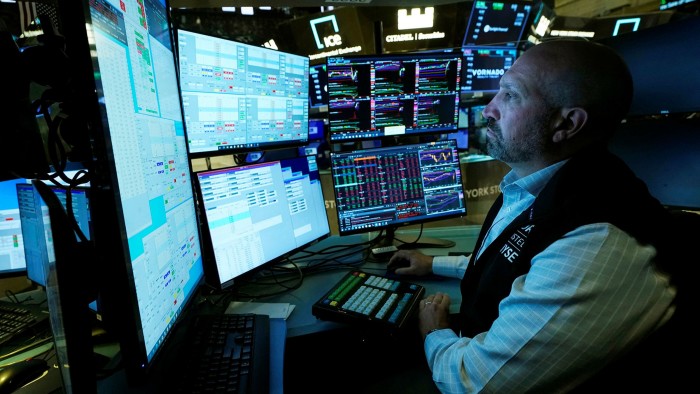Pace of US ETF launches doubles in space of two years

Simply sign up to the Exchange traded funds myFT Digest -- delivered directly to your inbox.
Interested in ETFs?
Visit our ETF Hub for investor news and education, market updates and analysis and easy-to-use tools to help you select the right ETFs.
Fund shops have pumped out ETFs at a breakneck pace so far this year in an attempt to capture a share of the massive inflows into the products.
Exactly 200 ETFs launched in the US during the first half of 2021, up from 131 during the same period last year and 100 between January and June 2019, according to data from CFRA Research. The 2021 figures include six mutual funds from Guinness Atkinson and Dimensional Fund Advisors that were converted into ETFs. Prior years’ data exclude products that have since closed down.
New types of investors had gravitated toward ETFs, which had driven new providers into the market, analysts said. Fund houses were churning out a wider range of ETFs to attract such clients, they noted.
Though some of the new products might not be around for the long haul, many had quickly amassed significant assets, said Todd Rosenbluth, director of ETF research at CFRA.
“Even with $6.5tn in US-listed ETF assets, we also expect more innovative and low-cost products to come to market in the second half of 2021 and new investors and advisers to discuss the benefits ETFs offer,” Rosenbluth wrote in his review of first-half sales and launch data.

This article was previously published by Ignites, a title owned by the FT Group.
In prior years, established ETF providers drove product development. However, this year, some of the biggest mutual fund managers have made a large imprint.
The new entrants include Putnam, Alger and Gabelli Funds, which each made their ETF debut using a non-transparent methodology, which shields an ETF’s portfolio from the wider market, thereby allowing active fund managers to operate without revealing their “secret sauce”.
In May, Putnam rolled out four strategies using Fidelity’s portfolio-shielding methodology, and Alger and Gabelli launched ETFs that use Precidian Investments’ ActiveShares system.
Dimensional, which made its ETF debut in November 2020, converted four of its mutual funds to ETFs in June. Those ETFs held $28.7bn of assets as of July 6, according to the group. American Century, meanwhile, has launched six active ETFs this year: one active non-transparent and five that disclose portfolio holdings daily.
Fidelity has also built out its ETF family with nine launches this year, including four clones of actively managed equity mutual funds, a series of active transparent fixed income funds and several income and environmental, social and governance-focused products.
Establishing products and track records was critical to laying the groundwork for future asset growth, particularly in emerging areas such as active, thematic and ESG strategies, said Matthew Bartolini, head of SPDRs Americas research at State Street Global Advisors.
Strong sales in areas such as active management are largely due to products launched a few years previously that have built up track records. Active ETFs attracted $7bn in net investment during the first half of 2021, according to State Street.
Yet managers also hope to supercharge growth by lining up significant assets for new ETFs. Some shops brought new ETFs to market with anchor investors, Rosenbluth said. For example, several institutions, including the California State Teachers’ Retirement System and Sura Asset Management, invested in BlackRock’s US Carbon Transition Readiness ETF (LCTU) on day one. The fund, which debuted in April with $1.2bn in assets, had $1.4bn as of July 6.
Some 16 ETFs that launched this year already have more than $100m in assets, CFRA data show.
But it is not just fund giants that are fuelling the surge in ETF debuts. Part of the boom can be traced to the proliferation of defined outcome or volatility-hedged ETFs, which usually originate in bunches. Providers, including Innovator Capital Management, First Trust, Pacer and TrueShares, launched 54 such products that aim to provide guardrails on how much downside risk stock investors assume, according to FactSet data.
Investors and manufacturers might be attracted to risk mitigation, said Lois Gregson, senior analyst for ETF analytics for FactSet. However, market watchers had given no indication that a big downturn was likely to be at hand, she said.
The markets had also shown an affinity for certain stocks that played on the themes of technological disruption, post-pandemic consumer behaviour and healthcare advancement, which was fuelling a proliferation of thematic equity ETFs, Gregson said. A total of 51 thematic equity products launched in the US between January and June, FactSet’s data shows.
Thematic ETFs are the industry’s way of saying, “we’re trying to appeal to a new type of investor,” Gregson said.
ETF product development appears unlikely to slow during the second half of 2021.
Dimensional plans to convert two more mutual funds to ETFs in the autumn and this week disclosed plans to launch four active bond ETFs.
T Rowe Price also intends to make its bond ETF debut in August. In addition, the US Securities and Exchange Commission could provide a green light this year for the crop of cryptocurrency ETFs under development. At least a dozen shops have disclosed plans to launch such ETFs.
*Ignites is a news service published by FT Specialist for professionals working in the asset management industry. It covers everything from new product launches to regulations and industry trends. Trials and subscriptions are available at ignites.com.
Interested in ETFs?
Visit our ETF Hub for investor news and education, market updates and analysis and easy-to-use tools to help you select the right ETFs.
Comments